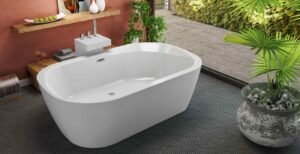All Bathtubs That Can Retain Heat Longer: All You Need To Know
From small children after a busy day to adults who want to relax after a long day of work, a warm bath can start a relaxing night and contribute to a good night’s sleep. To enjoy a long and warm bath in the bathroom, it is essential to choose a bathtub with a high heat retention effect. Cast iron is one of the best bathtub material for heat insulation.
Tubs that can retain heat
Enamel cast iron
Enamel cast iron bathtubs are highly durable and come in various colors. They also retain heat very well. Possible drawbacks are mainly cost and weight. An empty bathtub weighs over 300 pounds. Before installing these tubs, it is essential to make sure that the floor has sufficient support to support the tub.
If so, the enamel-coated cast iron tub retains the heat best. These tabs are also highly resistant to scratches, fading, and chipping.
Acrylic and plastic bathtub
Available in various colors, sizes, and styles, acrylic bathtubs are lightweight and durable. As long as the acrylic bathtubs are adequately insulated, they retain heat very well.
The acrylic bathtub has many advantages, including its texture, resistance to cracks and chips, and resistance to mold and harsh chemicals. The only downside to choosing an acrylic bathtub is that it can get scratched or soiled when exposed to suitable materials, such as hair dyes.
The plastic bathtubs also retain excellent heat, so you can enjoy long-term immersion without losing heat. Plastic tubs are a cheap option and are perfect for beginners’ homes. However, plastic is not as durable as most other bathtub styles.
Cast polymer tub
Cast polymers such as cultured marble, granite, and onyx are bathtubs that look like stones but can be shaped like synthetic materials. This type of bathtub is thicker than acrylic or fiberglass and are warm without the need for acrylic. A possible drawback of cast polymer bathtubs is scratches and other damage to the gel coating, which is not as strong as acrylic bathtubs.
Soapstone, brass, copper
Soapstone is a bathtub quality choice and ideal for keeping warm. While this type of bathtub is reliable in retaining heat, its cost and limited design options can be a disadvantage. Brass and copper store heat very well and are resistant to dents due to the thickness of the material.
The bathtub that does not retain heat
The advantage of fiberglass bathtubs is that they are affordable, lightweight, and offered in various styles and colors. Unfortunately, fiberglass tubs don’t retain enough heat and are prone to scratches and fading. Fiberglass is a cheap option for bathtubs, but it’s not as durable as acrylic.
Enamel steel is lighter than cast iron and is a popular bathtub material. Enamel steel tubs heat up quickly but do not retain heat. Unlike cast iron enamel, enamel steel is also easily chipped.
Frequently Asked Questions
Are you choosing the suitable bathtub material for your home?
The most common bathtub materials in home construction are fiberglass, acrylic, or ceramic. These are cheaper. So while it can be a great option if you have a limited budget, it doesn’t get too hot. Some are also porous, making cleaning these tubs a little more difficult as water and body oil penetrates the material.
On the high or custom side, you can find bathtub materials that retain heat much better. These include cast iron, marble, copper, porcelain, and stone resin. These are almost non-perforated.
That is, it does not remain moisture or dirt. However, more gentle cleaning is required to avoid damaging these high-quality materials.
How can I find out what an existing bathtub is made of?
Unless your home is custom designed and built, general contractors often use large warehouses to supply the homes they build. Most of these stores have acrylic and fiberglass tubs to keep costs down. If your tub looks like plastic and bends easily, it’s likely one of those materials.
Another easy way is to place a magnet in the tub. If it sticks, it is enamel-covered steel or cast iron. If not, there is probably an acrylic or fiberglass tub. If it is one of the rare materials such as ceramics, wood, and copper, they are so distinctive that you can recognize this with an unusual appearance.
Which bathtub material holds the most heat?
Cast iron, stone resin, or copper tubs provide the best insulation. These bathtubs are ideal for those who enjoy a long time in the bathtub in cold climates or without worrying about the water getting cold.
Especially cast iron loses heat slowly and evenly. It wouldn’t get as hot as metal and cools as quickly as plastic (acrylic or fiberglass).
Which material is the easiest to clean?
Porcelain, stone resin, cast iron, and copper are one of the most accessible bathtub materials to clean. What matters is the texture of the exterior, not the material itself.
For example, cast iron is generally easier to clean thanks to its glossy enamel coating, but stone resin is only plastic and tends to be easier to clean. It looks like a natural stone.
Can the bathtub rust?
Yes, some bathtubs may rust, depending on the material. For example, steel will rust over time when exposed to water uncoated. However, by coating the bathtub with enamel or porcelain, you can enjoy its benefits without worrying about corrosion and rust that can affect the bathtub and cause leaks. Therefore, it is important to repair chips and scratches as soon as possible.
Even if the body of the bathtub is not made of metal, metal parts such as faucets and drains can rust, especially over time. In this case, it is better to replace them with new equivalents.
Will the acrylic bathtub break?
Over time, most materials will deteriorate to some extent. Acrylic is no exception. It may crack due to rough handling or mere aging. In this case, small cracks can be filled with silicone sealant. Dry it, and you can go.
If you have an old bathtub that has been cracked due to aging, it may be time to upgrade. The good thing about replacing the tub is that more material is available than ever. So you don’t have to choose another acrylic tub. You can choose the one that best suitable with your lifestyle and budget.
Will the acrylic bathtub turn yellow?
No, the color of the acrylic tub is set when a layer of plastic is formed on the tub, so it’s unlikely that the acrylic tub will turn yellow. The material is non-porous, so if it is kept clean, discoloration due to contamination will not be a problem. If the acrylic tub is dirty, wash it with white vinegar and warm water.








